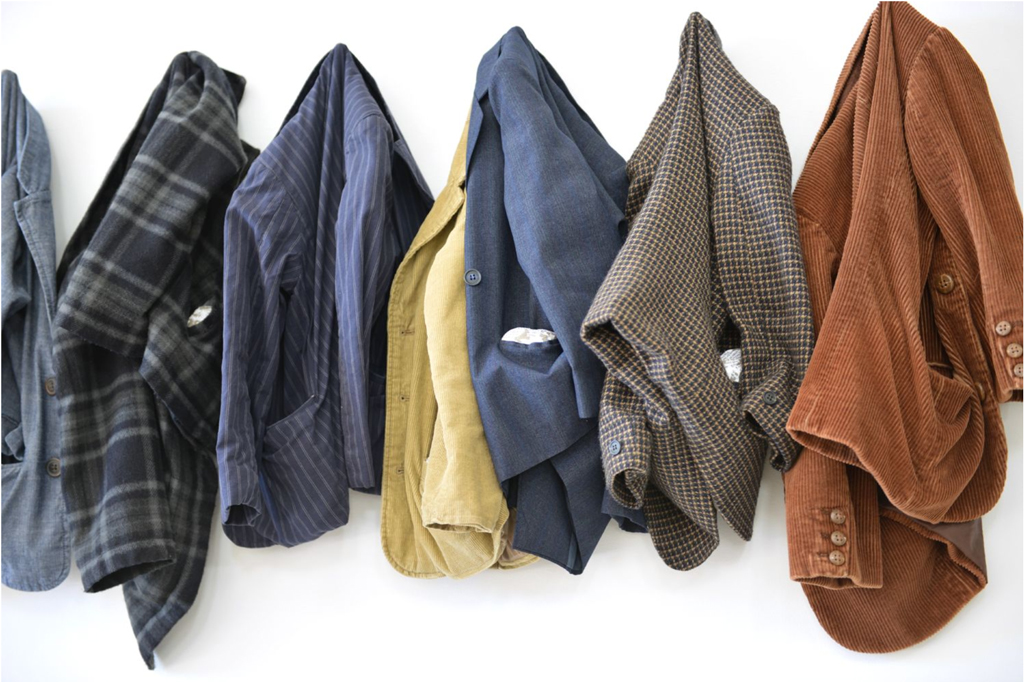[ad_1]
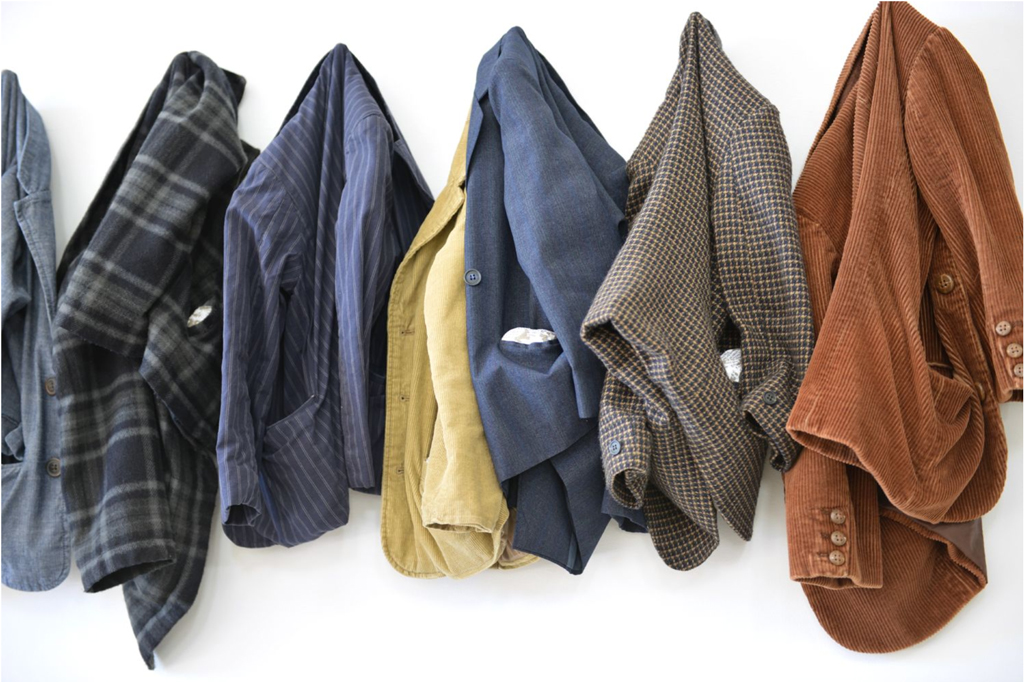
Stefana McClure, Protest Jackets: A New Siege (for Bernadette Devlin): a poem by John Montague, Punishment: a poem by Seamus Heaney, Viking Dublin: a poem by Seamus Heaney, The Ministry of Fear: a poem by Seamus Heaney, Ulster Names: a poem by John Hewitt, Derry: a poem by Seamus Deane, Procession: a poem by John Montague Funeral Rites: a poem by Seamus Heaney (detail), 2018, installation view.
COURTESY THE ARTIST AND JOSÉE BIENVENU GALLERY, NEW YORK
Living with Politics
We live in a world today of complex and often unfathomable politics, and we have many ways of circumnavigating the subject, passively or actively, angrily or thoughtfully. We can react with bloody depictions or reflect with poetry and nuance. Which is the more effective or satisfying expression is debatable, although the thinking ones allow for reason and greater balance. Call that Poetic Politics, a stance exemplified by artists like Stefana McClure and Annabel Daou.
The Irish-born and –raised McClure has staged her battles elegantly and compulsively using words as her forceful and enigmatic tools of expression and catharsis. Most recently, for her show at Josée Bienvenu gallery in New York, titled “Whatever You Say Say Nothing,” she typed out famous poems, letting her fingers appropriate them and shape them.
McClure’s practice has almost always involved a precise, elegantly compulsive investigation of subject and medium, working through action and translation by means of handcraft and literature. In the past she has copied by hand the complete subtitles from foreign films one line atop the last so that the meaning remains deeply embedded in the mass of graphite—literal, weighty, but indecipherable.
For her latest project, she said, “I thought I’d tackle something closer to home. I grew up in Belfast at the height of the ‘Troubles.’ ” McClure’s installation involved “drawings” based on typing out poems—by Irish authors—using IBM Selectric letter keys detached from the ball and then applied onto the fingers of gloves connected by ribbons and typed onto a Teflon surface. “The poems were typed by different people. Everyone has a different style,” she said, “and that accounts for the shape of the image.”
“The result,” she explained, has “nothing to do with the aesthetic.” There’s a performative quality, a percussive one. The “collaborators” included people from Craigslist and stenographers.
As a backdrop for all this there was a wall of wooden pegs serving as hooks for little boys’ school jackets. Inside the pockets of each jacket is a rock wrapped in crumpled paper with the typed poem, whose configuration, though randomly applied, nevertheless looks like a landscape. The rock is ready to be tossed when needed. The poetic missiles are waiting in pockets.
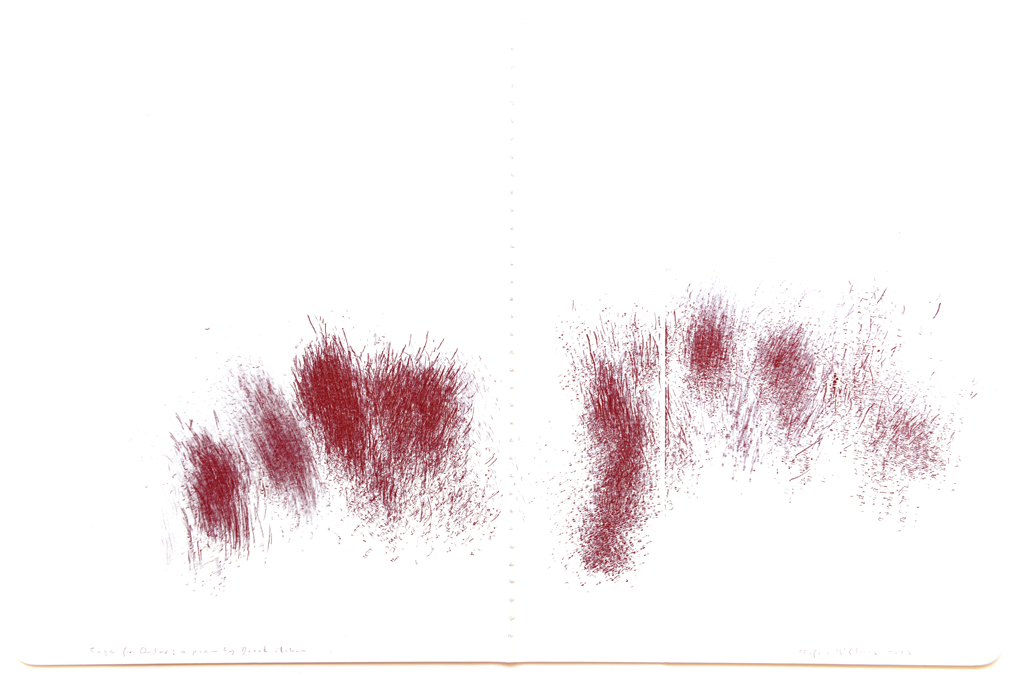
Stefana McClure, Rage For Order: a poem by Derek Mahon, 2018, teflon mounted on notebook cover.
COURTESY THE ARTIST AND JOSÉE BIENVENU GALLERY, NEW YORK
Among the poems are Philip Larkin’s “The Importance of Elsewhere“ and Seamus Heaney’s “Whatever You Say Say Nothing.”
From Larkin:
Lonely in Ireland, since it was not home,
Strangeness made sense. The salt rebuff of speech,
Insisting so on difference, made me welcome:
Once that was recognised, we were in touchTheir draughty streets, end-on to hills, the faint
Archaic smell of dockland, like a stable,
The herring-hawker’s cry, dwindling, went
To prove me separate, not unworkable.Living in England has no such excuse:
These are my customs and establishments
It would be much more serious to refuse.
Here no elsewhere underwrites my existence.
From Heaney:
And I’m writing just after an encounter
With an English journalist in search of ‘views
On the Irish thing’. I’m back in winter
Quarters where bad news is no longer news,Where media-men and stringers sniff and point,
Where zoom lenses, recorders and coiled leads
Litter the hotels. The times are out of joint
But I incline as much to rosary beadsAs to the jottings and analyses
Of politicians and newspapermen
Who’ve scribbled down the long campaign from gas
And protest to gelignite and Sten,Who proved upon their pulses ‘escalate’,
‘Backlash’ and ‘crack down’, ‘the provisional wing’,
‘Polarization’ and ‘long-standing hate’.
Yet I live here, I live here too, I sing, . . .
Meanwhile, closer to home, in Brooklyn, McClure reacted to other disturbances: “I wrote the first of the poems and knocked the corners off the paper,” McClure told me. “I got stones from my garden. We had a stone basement, and I threw stones against the wall.” Her anger was inspired not only by politics and the state of the world, but it was also in large part a response to the noise of construction being done across the street.
“I put my whole body into it,” she said. “A big stone being thrown hard has a percussive quality to it.”
“As kids,” she added, “we always had a stone in each pocket. I’ve made works like Beckett’s sucking stones passing from pocket to pocket so that each stone is sucked. There’s a sense of safety in having them.”
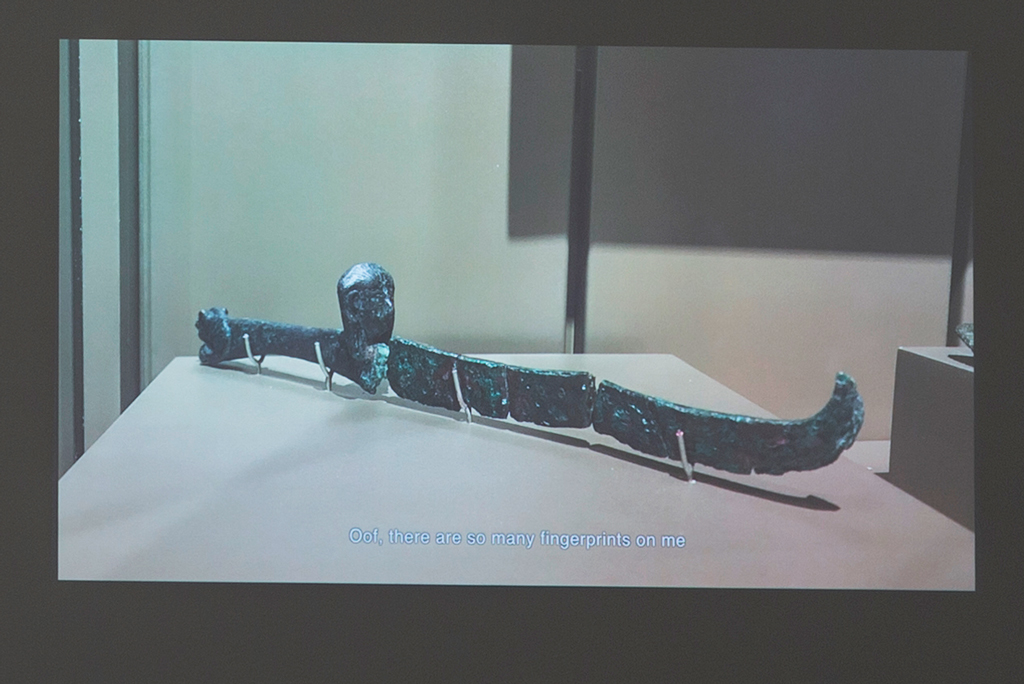
Annabel Daou, chou hayda / if you only knew, 2017–18, HD video, installation view.
COURTESY GALERIE TANJA WAGNER, BERLIN
Lebanon-born artist Annabel Daou, whose practice also involves compulsive writing and performance has in the past copied by hand the entire Constitution of the United States, as well as literary texts, just like McClure, visually suggesting landscapes with hills and valleys decreed by density of writing. And she, too, often works with collaborators in the writing. She has long used embedded words as the lines in her drawings.
Most recently she created a project for the National Museum of Beirut, in Lebanon, in which she gave visitors—many of whom had never been in the museum before—the surprising role of collaborators. Daou put them in a place of authority, where they provided the material for an audio guide, thus enabling the museum’s ancient artifacts to speak to and through those interpreters. The project, Daou said, was “a collaboration between me and the people of Beirut.”
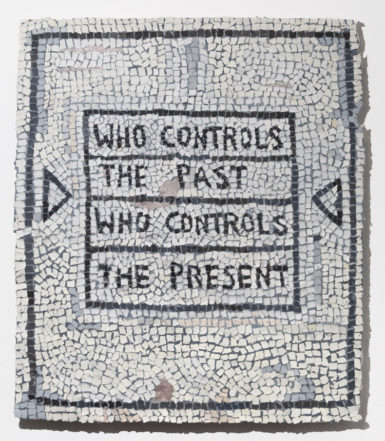
Annabel Daou, who controls the future?, 2018, paper and graphite on gesso.
COURTESY GALERIE TANJA WAGNER, BERLIN
Titled Chou Hayda (or What is This?), the exhibition of works from the museum’s collection is on view through December 30, and available at chouhayda.com. It involves historical objects from every period and visitors pondering and answering questions. They first were asked a series of questions to which they responded with curiosity and imagination. In response to viewing a sculpture of two marble figures, for example, they were asked, “Who has authority here?” Responses included, “They have more authority than we do because . . . they have more presence.”
As they observed the objects from the past, Daou’s “collaborators,” as she recalled, “did not attempt to disclose a particular historical narrative. Nor did they attempt to create a fiction. They did not lie and they did not try to tell the truth.” Looking at the past from the uninformed present time and recontextualizing it yields both expected and surprising results.
Her own recent work, on view at Tanja Wagner Gallery in Berlin through January 26, also demonstrates the conjunction of past and present materially and metaphorically. Daou makes fragile torn-paper mosaics on sheer translucent fabric allowing the absorption and reappearance of figure and ground to shift. Words are not set in stone, but on ephemeral materials. Difficult but not contentious, Daou’s words, political and/or personal, require introspection. She has experienced war but, tries to contextualize her experiences in history.
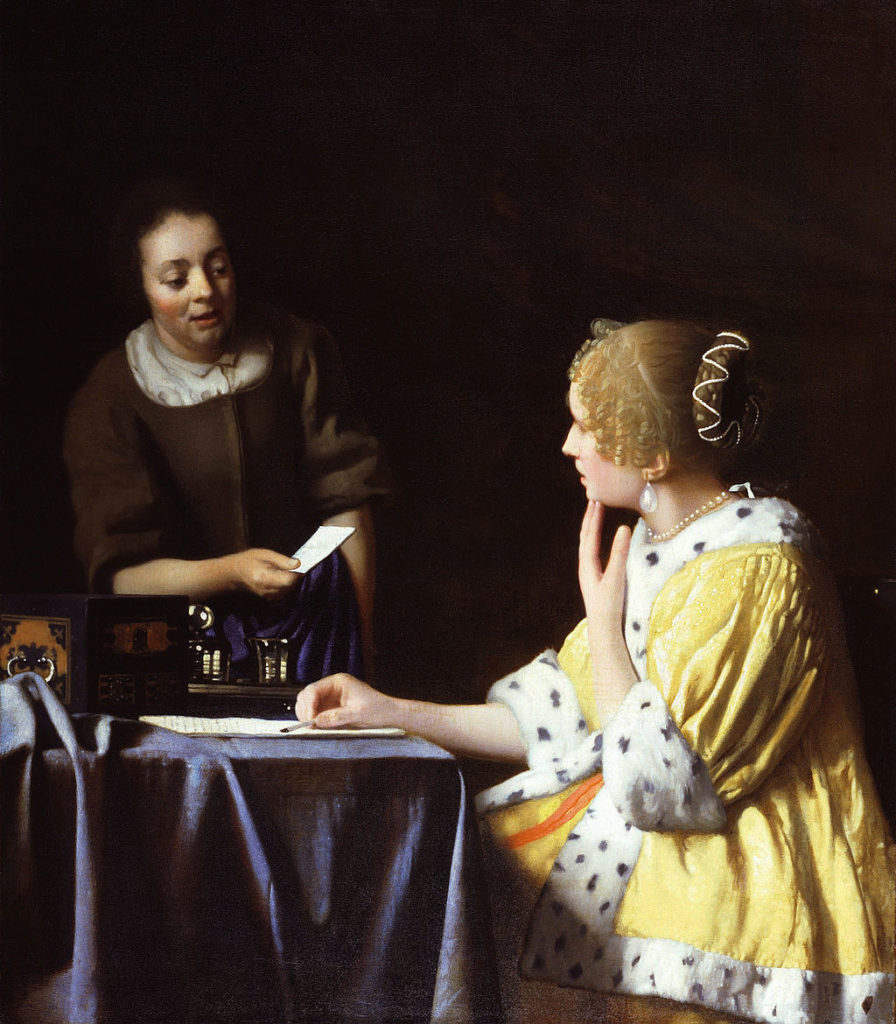
Johannes Vermeer, Mistress and Maid, ca. 1667, oil on canvas.
THE FRICK COLLECTION, NEW YORK
Vermeer’s Mistress and Maid: A Backstory
The Frick Collection in New York is fostering fascinating new relationships between its artists and those who would interpret them, adding literary depth and breadth where art history alone has gone before. A new series of books, published by the Frick in association with D Giles Limited in London, puts together art history and the creative inventions of contemporary artists and writers.
Most recently, from the “Frick Diptych” series, comes the volume Vermeer’s Mistress and Maid, by Margaret Iacono, associate research curator at the Frick, featuring an essay by Iacono, and a fictional work, “Two Letters on a Day in the Mid-1660s,” by film director, producer, and screenwriter James Ivory. Iacono gives a behind-the-scenes historical account, contextualizing the painting art historically and culturally and discussing its technique, while Ivory creates a masterful, romantic filmic vignette that suits our present time, where we are free to welcome fiction as reality.
Ivory describes in an introduction to his essay how he grew up in a small Midwestern town and had “never been in any kind of picture gallery” until he was ten. However, planted in his mind was a small reproduction of Franz Hals’s Laughing Cavalier (1624) that hung in the home of his family, with whom he’d travel hundreds of miles once a year on his mother’s birthday to visit the “large art museum” in San Francisco’s Golden Gate Park. Later, while in college, he developed a love for El Greco, Goya, Chardin, and Vermeer, which he’d gleaned from illustrations in books. Then, on his first visit to the Louvre, he became enamored of Goya’s Marquesa de la Solana (1795) “all dressed up for her artist.” Finally, he visited the Frick, where he found himself drawn to the Mistress and Maid painting, which appealed for “the proverbial calm and still surfaces” he perceived in Vermeer’s art, “ruffled by one of the deepest and most universal of human emotions: the psychological tension contained within the gesture of a proffered, sealed letter.”
As storyteller, Ivory goes on to describe the contents of the bright white envelope in the image, which steals our attention as it extends between the hand of the maid above that of the pensive, plotting mistress, who may be penning a response to a missive from a suitor. Ivory assigns his subjects’ names—hers Cornelia; the suitor’s, Ludolph; and the man she is in love with, Adriaen.
It’s an operatic comedy of errors, as Ivory presents it, on the verge of a 17th-century farce filled with lies, a complicit maid, and an abundant string of absurdities (no deaths). In the telling, after Cordelia’s father forces her to visit Ludolph, she finds that the unwanted suitor’s house had partly flooded and “he seemed more interested in saving his valuable swimming chairs and caskets than in saving her.” Turns out he handed her over to his “tall and strong” servant (whose “skin, though brown, was as smooth as silk”). He picked her up, carried her out, and placed her in her father’s boat and then “set her down on a wooden case stamped with black letters, ‘Arcelli Fontana Castello di Monteventano.’”
Not to be forgotten was the other letter—this one from Adriaen. Cornelia grabbed it. Amalia, the maid, was one day taking Ludolph to her mistress, when he pushed her into a corner beneath the stairs “near a closet,” and had his way with her.
Margaret Iacono relates a different tale: the real life of the painting itself after it was purchased by Henry Clay Frick for his personal collection at the end of World War I. Frick, who had a penchant for Dutch Golden Age works, ended up purchasing three Vermeers, ultimately paying a total, by his own reckoning, of $299,989.50.
Of Vermeer himself, who was born in Delft in 1632 and died there in 1675, we learn that his father began as a weaver of silk and later became a picture dealer. Less is known about Vermeer’s artistic training, but Iacono mentions that he became a member of the Delft Guild of St. Luke, a professional trade organization, which gave him the right to sell his own paintings as well as those of others. He married a wealthy woman and had 11 children, but being a slow producer, he later ran short of money, suffered from stress, and died in debt.
As for the subject of the painting, we see the maid as a familiar figure in the period. Men were in the maritime profession, and the domestic labor force in Delft was composed largely of women. Iacono discusses the representation of maids at the time, noting that they were often shown as lazy, sometimes conspiratorial, sometimes protective of their mistresses, as well as gossipy, devious, and unsurprisingly, immoral.
It was considered important that maids and mistresses be attired differently so as to identify the characters and their status, and here the maid happens to be quite well-dressed, indicating Vermeer’s own more accepting attitude toward the staff.
[ad_2]
Source link

